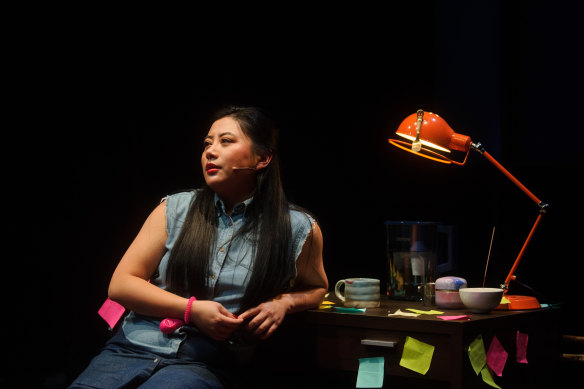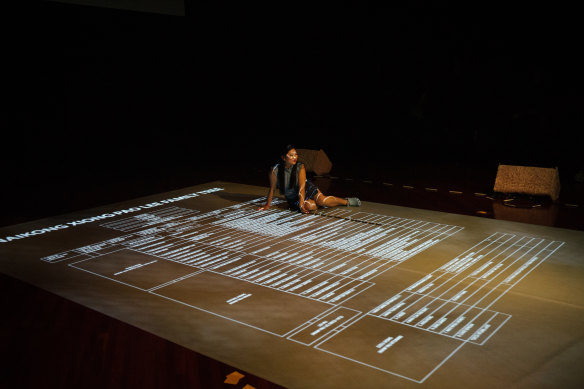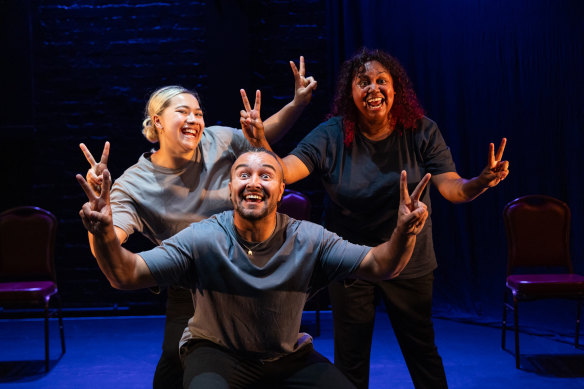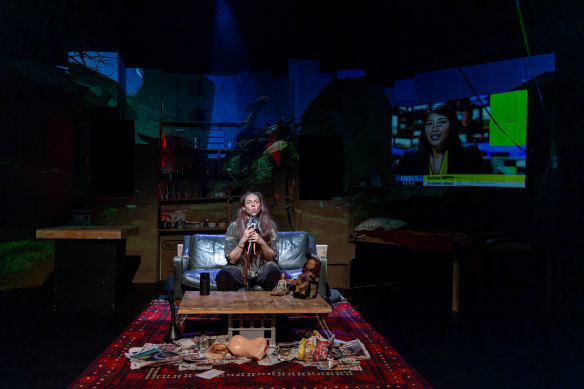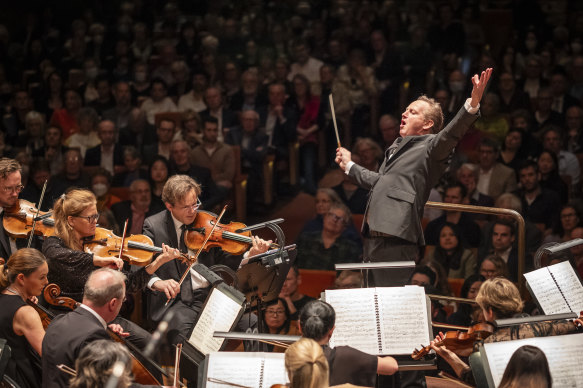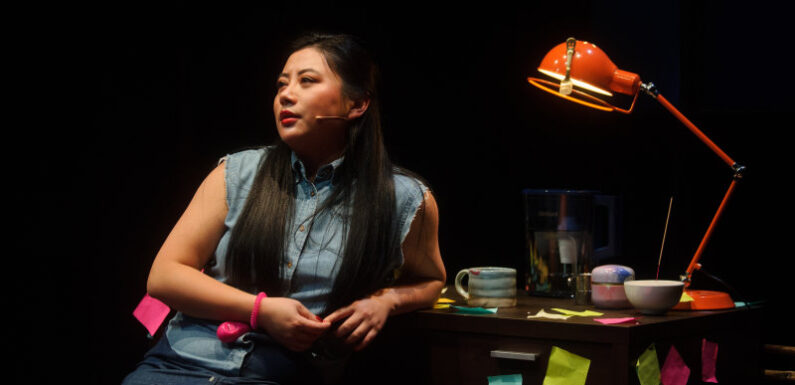
Save articles for later
Add articles to your saved list and come back to them any time.
Key points
- THEATRE: How Do I Let You Die? explores grief and family ties.
- THEATRE: A Daylight Connection presents a thought-provoking double bill.
- MUSIC: Australian World Orchestra offers up a five-star performance.
This wrap of shows around Melbourne includes a show that reaches past life and into what comes next, a double bill by a wildly inventive theatre company, and a five-star performance by the Australian World Orchestra.
THEATRE
How Do I Let You Die? ★★★
Arts House, until November 26
Once again turning her lens on to herself, Michele Lee examines the spectre of mortality and death in How Do I Let You Die? – as it relates to her life, her parents, and Hmong rituals of grieving.
Alice Qin performs the role with a disarming intimacy.Credit: Sarah Walker
The ghosts in How Do I Let You Die? are the ghosts of intergenerational trauma; of family lore and secrets left unspoken and allowed to fester in the chasms that form between Lee’s family members; of spirits, curses and demons that lay dormant in their bodies until they don’t.
Alice Qin plays Lee with a disarming intimacy that belies the fact that it’s not her life that’s being laid bare – photos of Lee are splashed onto the surrounding screens and it’s snippets from verbatim conversations she has with her parents every day throughout the month of February 2020 that anchor the play.
The sparse set – where a long white canvas takes up the floor – becomes a site for the excavation of self. Credit: Sarah Walker
The repetitive, circuitous nature of these phone calls feels intentional – Lee and her parents circle around what they really want to say to each other, constrained both by limitations in language and an inability to comprehend one another fully. This play is Lee finding a way back to them and beyond them once they pass on.
The conversations switch back and forth between Hmong and English, surtitled on a large screen for the audience’s benefit – similar to Michelle Law’s Miss Peony with its use of Cantonese, Mandarin and English. When this screen isn’t displaying dialogue, it’s playing an intentionally cheesy horror film where Qin is being stalked by a menacing ghost in the inner suburbs of Melbourne.
How Do I Let You Die? oscillates between many different modes, some more successful than others – it’s part-history lesson, part-dramedy, part-horror. At times, the transitions between each can feel jarring, and dramatic tension is lost. The play holds space for a multitude of themes and ideas, though the result is, at times, an incohesive play that is trying to cover too much in a scant 90 minutes.
The sparse set – where a long white canvas takes up the floor – becomes a site for the excavation of self; literally, like when Lee’s family tree is projected onto it, and in more oblique ways when Qin slithers across like a worm or sits cross-legged, assuming a position of comfort typically reserved for the private spheres of our homes.
The play is unbearably sad in many ways as it grapples with ageing migrant parents’ inadequacies and frailties. As Qin monologues about Lee’s personal and family history, the history of Hmong people – who make up a mere 4000 in Australia – How Do I Let You Die? is a plea to be seen.
Reviewed by Sonia Nair
THEATRE
Chase ★★★★
Whose Gonna Love ’Em? I am that i AM ★★★
A Daylight Connection, Malthouse Theatre, until December 3
A Daylight Connection has taken First Nations theatre in wildly experimental directions since it was formed last year. Spearheaded by Kamarra Bell-Wykes and Carly Sheppard, the collective embraces consciously radical aesthetics that rebel against every imaginative shackle and tired assumption of what First Nations performance might be or become.
Maggie Church-Kopp, Corey Saylor-Brunskill, and Maurial Spearim in a scene from Whose Gonna Love ’Em? I am that i AM.Credit: Jacinta Keefe
Its current double bill at the Malthouse showcases the ambition and variety of its theatre-making. Both works embody active resistance, and deliver penetrating critique, of contemporary culture, though they’re strikingly different in tone and performance style.
Winner of the Patrick White Playwrights Award in 2021, Kamarra Bell-Wykes’ Whose Gonna Love ’Em I am that I AM is incantatory theatre for a chorus of three actors (Maggie Church-Kopp, Corey Saylor-Brunskill, and Mauriel Spearim).
Carly Sheppard plays Chase, a young First Nations woman and the last person left alive on the planet,Credit: Jacinta Keefe
Trauma is its theme, and the work gives a genuine voice to the voiceless. Its bruised song rings true to the lived experience of PTSD; it also delves deeply into the misalignment between a suite of modern therapies (medical, religious, and alternative) and trauma-sufferers marginalised by race, culture, and class.
Conceived as a form of group therapy, the piece is guided by a therapist through a detached voiceover. Value-neutral she is not. You’re likely to be alienated by degrees on the wall if you’re uneducated and swear like a sailor, never mind the happy snaps from Bali and Tahiti if your ancestors survived colonial genocide.
Bell-Sykes doesn’t ultimately allow this theatrical exploration to be overwhelmed by fragments of intergenerational trauma – of nightmares, rage, disassociation, powerlessness, and terrors relived. A tentative and hard-earned hopefulness does emerge – a more sensitive approach that verges on ritual, underscored by the insistent tranquillity of smallsound’s music.
Tranquillity does elude the apocalyptic, black comic frenzy in Chase, which feels like a prequel to A Nightime Travesty performed at this year’s Yirramboi Festival.
Carly Sheppard plays the title character, a young First Nations woman and the last person left alive on the planet when human society is annihilated by climate catastrophe and nuclear war.
Still, the foul-mouthed, bedraggled Chase remains irrepressible, even as she’s enmeshed in cultural forces that brought the world to this pass.
“No c—’s an island,” as she chirpily livestreams from her squalid home. But hang on, isn’t everyone dead? No worries. Chase has plastic dolls for company, from Influenza (a vacuous narcissist and social influencer) to Traditional Girl (a wordless Aboriginal doll), and her desperate ventriloquism fuels a delusional internet show.
As Chase hunts ants and cooks cockroaches and dolls herself up for a party fit for the end times, she keeps urging viewers to “like and subscribe”.
Chase is a profane and provocative comedy horror. It manifests a berserk style of surrealist theatre drawn from the collective unconscious, from the destructive ideologies and ethics underlying the way most Australians live now.
A radical solo show that’ll shock you out of complacency, it’s also shockingly funny. You can’t look away from Sheppard, who slips magnetically between deadly social satire, mischievous parody, and scuttling, demonic, almost Butoh-like physical theatre.
And both Bell-Wykes’ direction and Alex Mansell’s video design augment the hellscape of horror and humour Chase unleashes.
Reviewed by Cameron Woodhead
MUSIC
Mahler 9 ★★★★★
Australian World Orchestra, Hamer Hall, November 22
Eagerly awaited and never disappointing, this year’s appearance of the Australian World Orchestra, a reunion of many of Australia’s best orchestral musicians from across the globe, resulted in a magisterial account of Mahler’s Symphony No. 9.
Australian World Orchestra perform Mahler 9.Credit: Helga Salwe
Written during a period when the composer was challenged by the death of his daughter, tensions in his marriage and the diagnosis of a life-threatening heart condition, the symphony is a supreme act of musical catharsis in which Mahler confronts his demons and creates a unique and astonishing testament to the enduring value of human life.
Under the baton of the orchestra’s founder Alexander Briger, the players manifested their formidable knowledge and love of the music in a performance of finely honed detail and intense emotional energy.
Such precision and power paid immediate dividends in the lengthy opening Andante, where its haunting allusions to death and extraordinary orchestration were illuminated by an adroitly nuanced sense of timbre particularly in the wind and brass. Briger’s grasp of musical architecture ensured that its successive climaxes gathered telling dramatic impetus.
Displaying enormous versatility, the orchestra vibrantly inhabited the strange sound-world of the inner movements. The perverse black humour of the second movement in which a rustic dance takes on a ghoulish character was well realised, while the third-movement Rondo-Burleske bristled with vehemence.
Initiated by searing string tone, the symphony’s long, aching apotheosis was delivered with compelling sincerity, rising and then falling into a mood of quiet hope, aided by slowly dimmed house lights.
Remarkably conducting the 90-minute-long score from memory, Briger channelled the players’ obvious camaraderie into a life-affirming encounter that recalled the landmark Melbourne performance of this work by the Chicago Symphony under Georg Solti in 1988. For another generation, this account will live long in the memory of those fortunate enough to have experienced it.
Reviewed by Tony Way
The Booklist is a weekly newsletter for book lovers from books editor Jason Steger. Get it every Friday.
Most Viewed in Culture
From our partners
Source: Read Full Article
